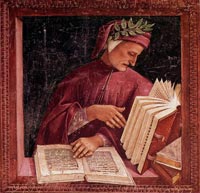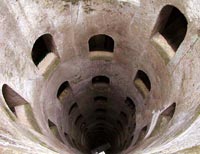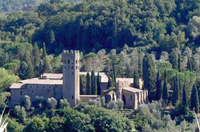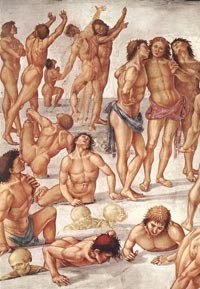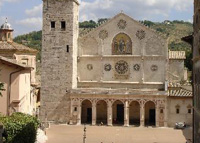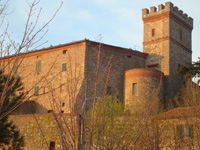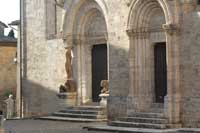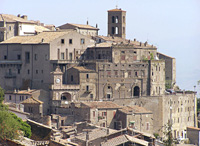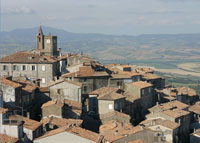|
| The site of Orvieto is among the most dramatic in Europe, rising above the almost-vertical faces of tuff cliffs that are completed by defensive walls built of the same stone. Located on a plateau of volcanic tuff, the impressive city of Orvieto is surrounded by a stupendous landscape of fields and vineyards; the unbreachable walls appear to encircle the city rather than elevate it, as though it were a fortress rising on the flat valley floor of the river Paglia. Orvieto still preserves its charming Medieval character, thanks to its location, to its Etruscan roots and to its celebrated Cathedral. Orvieto flourished in the Middle Ages when it became a powerful Comune. The majestic monuments of this period include the Palazzo del Capitano del Popolo, the Torre del Moro and the Torre di Maurizio, at one corner of Piazza del Duomo. But Orvieto is known above all for its Duomo (Cathedral), this incredible example of Italian Gothic architecture. The cathedral houses many works of art, with pride of place going to the San Brizio chapel and Luca Signorelli's frescoes of the End of the World (1499-1504). |
From the top of the 47 meter high Torre del Moro, the eye can range over the roofs of the entire city to the towns and castles in the territory of Orvieto. The tower known as Torre del Papa is almost perfectly aligned with the four points of the compass. In the 16th century the Torre was renamed del Moro, almost certainly after Raffaele di Sante, known as 'il Moro', who gave his name to Palazzo Gualtiero beneath and to the entire quarter. Orvieto’s Gothic cathedral, which is one of the most celebrated in Italy, was begun in 1290 to commemorate the miracle at Bolsena, a town situated just to the southwest, where in 1263 a priest witnessed the miraculous appearance of drops of blood on a Host that he was consecrating. A large silver shrine in the Cappella del Corporale contains the Holy Corporal (linen altar cloth) from Bolsena. The cathedral's west facade, a fine polychrome monument of richly sculptured marble, is divided into three gables with intervening pinnacles. The interior of the building is richly decorated with the work of a number of medieval sculptors and painters, notably the frescoes by Luca Signorelli and Fra Angelico in the Cappella Nuova. |
||
 |
||
| Enlarge |
||
Traces from Etruscan, medieval, Renaissance and other periods all blend into an urban whole, rising from which are the great Gothic Duomo, or Cathedral, the Papal Palaces and the 13thcentury Palazzo del Popolo, or Town Hall. With excellent art and archeological museums, a wealth of religious and civic architecture of the first order, paintings and sculptures of fundamental importance to Italian art history, and an excellent craft tradition, Orvieto is an essential stop on any travel itinerary in Umbria. |
||
Orvieto, Duomo |
||
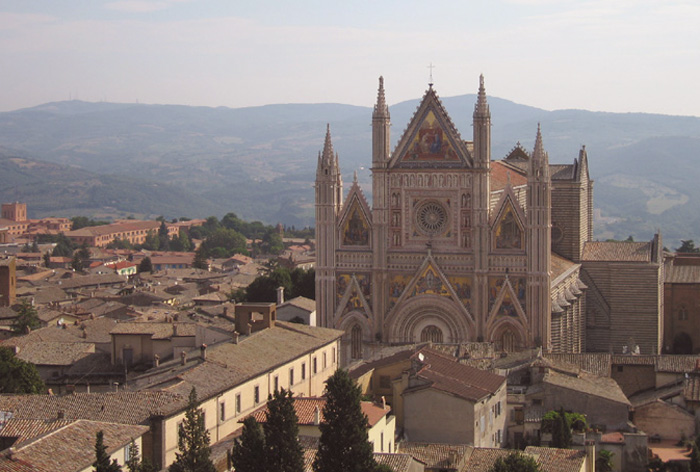 |
||
Orvieto, Duomo |
||
| The Duomo of Orvieto is one of the most important examples of Gothic architecture in Italy. The facade, a great triptych built by Lorenzo Maitani in the first years of the 14th century, is richly decorated in a dazzling mixture of polychrome marble, sculptures and mosaics, is certainly the prime masterpiece of Italian decorative Gothic. The middle entrance of the Duomo and the central rose window were designed by Andrea Orgagna in the 14th century. The interior is partly Romanesque in style, whereas the presbyterium is Gothic. Inside the cathedral, the Chapel of San Brizio is frescoed by Fra Angelico and with Luca Signorelli's masterpiece, his Last Judgment and the magnificent bronze portals. The Cappella Nuova is one of the best known masterpieces of Renaissance Italian art. The chapel is set on the right wing of the Dome's transept where there were also the sacristy and a semi-cylindrical small chapel belonging to the Monaldeschi family. The chapel was built between 1406 and 1425 and Beato Angelico and Luca Signorelli worked on the decorations of the entire chapel. The small chapel of Corpi Santi portrays an entirely different atmosphere that reigned during the vigil over Christ's body. Signorelli also painted an exquisite portrait of himself and his fellow artist, Fra Angelico, who was renowned for his artistic genius and his utter Christian devotion. These two portraits are seen on the wall featuring the stories of the Antichrist. [read more] Duomo | Free, open April-Sept daily 7:30-12:45 & 14:30-19:15; March and Oct closes at 18:15, Nov-Feb at 17:15. Chapel of St. Brizio | €5 (includes the Museo dell'Opera del Duomo), open Mon-Sat 9:00-12:45 & 14:30-19:00, Sun 13:30-18:30 (closes one hour earlier in winter). Buy your ticket at the chapel or at the TI in Piazza del Duomo. |
||
 |
||
Orvieto: Duomo, detail [5]
|
||
Chapel of the Corporal The Cappella del Corporale lies on the north side of the main crossing. It was built between 1350 and 1356 to house the stained corporal of the miracle of Bolsena. It is from this chapel that the reliquary with the corporal is transported for religious processions through the town on feast days. |
||
| Visiting the National Archaeological Museum in the Piazza del Duomo, as well as visiting the just as unmissable "Claudio Faina" Archaeological Museum, will establish an intriguing and useful contact with
the social and cultural reality of what once was one of the most important and flourishing cities in Etruria. In fact, the Museum halls host admirable and valuable findings, grouped according to topography,
that were brought to light during research activities in the necropolis and the sanctuaries of the territory surrounding Orvieto, as well as those that accidentally resurfaced during works carried out in the city. Located on the ground floor of the Papal Palace, the Museum hosts materials of great interest coming from the necropolis of Crocifisso del Tufo, Cannicella, Fontana del Leone, Settecamini, Porano. Particularly distinguished are precious Etruscan pottery items with red figures, a complete bronze armour composed of a helmet, a cuirass, a pair of greaves and a shield, and some collections of artefacts from graves, rich in findings both imported and locally produced, such as the buccheri. Particularly inviting is the area where the two famous chamber-tombs have been rebuilt (the so-called "Golini 1" and "Golini 2") which were discovered in 1863 by Domenico Golini in the Porano area; the original frescoes have been detached from the tombs for conservation purposes. The paintings describe the themes of funeral banqueting and the descent to the underworld and offers a rich and beautifully detailed interesting example of the Etruscan rituals. The hall dedicated to the Cannicella necropolis is worth a visit, as it helps putting together the information on this area located on the southern slopes of Orvieto's cliff. Starting from the second half of the sixth century, an important holy place was established in this area, which had been occupied by a necropolis in Archaic Ages, with street-grid characteristics similar to the Crocifisso del Tufo Necropolis; the holy place had a temple decorated with important terracotta ceramics and a series of related buildings, possibly needed for marginal purposes. In this case too, you can admire ceramic and bronze items discovered in tombs, many of which were found during the nineteenth century following extensive excavation campaigns.[1] |
||
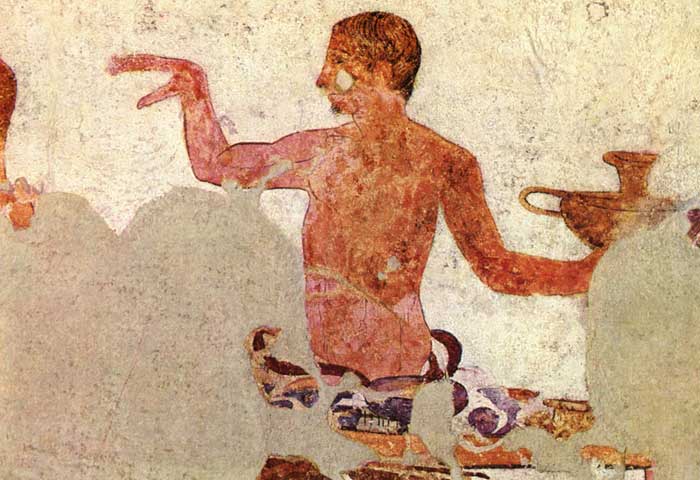 |
||
Preparation for the feast (detail), ca. 340—280 B.C. Orvieto, Golini tomb
|
||
| Fondazione Museo Claudio Faina | Archaeological Museum The Museo Faina contains one of Italy’s finest archaeological collections, brought together by two aristocrats, Mauro and Eugenio Faina, who from 1864 went personally on digs and acquired items on the open market. Located in Palazzo Faina, the Museo Claudio Faina is directly opposite the Duomo and extends on two floors of the building. Archaeological Museum Piazza del Duomo, 29 |
||
 |
||
Palazzo Soliano and Museo Emilio Greco, next to the cathedral, Orvieto [4]
|
||
| Palazzo del Capitano del Popolo |
||
| A short distance north of the Torre del Moro in Orvieto is the Piazza del Capitano del Popolo (markets held on Thursdays and Saturdays), with the 11th century Palazzo del Popolo, built in volcanic tufa stone. The original Palazzo del Capitano was a single ground floor loggia that was used as a market place or for meetings. The stairs that led up to the loggia had originally flanked one of the perimeter walls of the previous building. A number of important buildings in Orvieto mirror certain architectural elements of this palazzo, from the bishop’s palace to the Palazzo dei Papi, as well as a number of family houses. Details such as the grandiose arches that support the ground floor of the building, or the chequered cornices of the windows, appear recurrently throughout the city. |
||
The Palazzo Comunale The painted decorations in the Salone of the Palazzo Comunale were carried out between 1345 and 1347. |
||
Papal Palaces. The three palaces of the popes built in the 13th century house the National Archeological Museum and the Opera del Duomo Museum, with key works of Orvieto art from the Middle Ages to the 18th century. It preserves works of Simone Martini, Luca Signorelli and Andrea Pisano's sculptures. On the ground floor is the "Emilio Greco" Museum. |
||
| The Palazzo Soliano of dei Papi or Papal Palace was a 13th century residence of mediaeval popes, now it houses the Museo Archeologico Nazionale with Etruscan finds from the Orvieto and The Museo dell'Opera del Duomo containing pictures by Andrea Pisano, Nicolo Nuti, Simone Martini, Ippolito Scalza and Francesco Mochi. The city of Orvieto has long kept the secret of its labyrinth of caves and tunnels that lie beneath the surface. Dug deep into the tuff, a volcanic rock, these hidden and secret tunnels are only now open to view through guided tours. Their spectacular nature has also yielded many historical and archeological finds. The Pozzo di San Patrizio is a 62 meter deep well, originally dug by the Etruscans as a well and enlarged between 1527 and 1530. The Pozzo di San Patrizio is a Renaissance well with two helicoidal staircases constructed by Antonio da Sangallo to provide water supplies during sieges.
|
|
|
Museo Emilo Greco € 2.50, € 5.50 includes St. Patrick's Well, open sporadically — maybe Fri–Sun 10:30–13:00 & 15:30–17:00, closed Mon–Thu, even shorter hours off-season, tel. 076-334-4605. |
||
| The Palazzo del Vescovado, or former bishop’s palace, dates back to the reign of Pope Benedict VII, who gave orders for the building to be erected in 977 next to the church of Santa Maria Prisca. The rear façade of the building also contains magnificent windows that look onto the palace kitchen garden, in Via Cesare Nebbia. The fine decorative architectural details such as the capitols testify to the grand scale of the building and to the high artistic standards maintained in Orvieto in the second half of the 13th century.
Part of the palazzo houses the Museo Archeologico Nazionale, which contains the interesting Golini I and II tombs dating from the 4th century BC. |
||
| Chiesa di Sant'Andrea (e Bartolomeo) |
||
| Nearby, in Piazza della Repubblica, stands the 12th-century Chiesa di Sant'Andrea and its curious decagonal bell tower. The Chiesa di Sant Andrea (Saint Andrew's Church) was once an important gathering place for Orvieto’s religious powers. Even earlier, during Etruscan times, a central temple stood here. |
||
| Piazza Cahen was named for Edoardo Cahen, a Jewish banker who provided funds for the struggle to achieve a united Italy. He was made a marquis by King Umberto I in 1885. |
||
Underground Orvieto Tours | Guided tours at the "Underground city", Piazza Duomo, 23 www.orvietounderground.it |
||
| Walk across the facade of the Madonna del Velo to join a trail around Orvieto known as the Anello della Rupe (ring around the cliff). Continue to the point where the Cappella del Crocifisso del Tufo was cut into the rock in the 16th century. There is an interesting view of the necropolis of the Crocifisso del Tufo from the viewing point beyond on the left. You can continue to the necropolis from this point, and then return to Santa Maria del Velo.A large sector of the annular necropolis of Velzna (Volsinii) characterized by a regular urban layout, with cube tombs. The Etruscan Crocifisso del Tufo necropolis, situated just outside of Orvieto, dates back to the 6th century BC. Laid out as a neat little village for the dead, you can wander around it and visit most of the tombs. 'The arrangement of the tombs, which follows a definite “town” plan, provides precious elements for the study of the layout of the ancient city. Built from blocks of tuff, the entrance lintels of the tombs are inscribed with the name of the deceased.'[3] Not much is left though of what used to be inside them: just one, two or three "beds" in each tomb (often complete with inbuilt stone pillow). Everything else was either stolen or removed to museums (amongst others the Museo Claudio Faina e Civico up the hill in Orvieto). Of particular interest are the remains of the Etruscan sanctuary of Cannicella dating back to the 4th-6th centuries B.C. The Cannicella Necropolis and Sanctuary are situated along the slopes of Orvieto's cliff, west of the town, almost on the opposite side to the Crocifisso del Tufo Necropolis. The most important find from the site was the so-called “Venus” of Cannicella, which Riccardo Mancini discovered (along with the temple itself) in 1884. The Cannicella Venus, a statue in Naxian marble, is currently on display at the Museum of Palazzo Faina. The Cave of the Fossil Tree Trunks, located along the loop of the cliff near the access to the Archaeological and Environmental Park (PAAO) near Piazza Cahen (go on to porta Soliana, than turn right on the way to Cannicella), is a very interesting artificial cave, hosting paleobotanical remains dating back to 350 thousand years ago, belonging to the ecosystem that existed well before human presence, and preceded the formation of the tufa rock cliff on which Orvieto rises. |
||
| |
||
| The charming village of Porano dates back to the Middle Ages. Its most impressive buildings are without a doubt Castel Rubello (from Castrum Bellum), a fortress that dates back to the Romans, and the architectural complex of Villa Paolina, with its large grounds laid out in the 17th and 17th century that include a number of rare and established plants. But most of the countryside around Porano is scattered with Etruscan archaeological remains. The large number of sumptuously painted burial chambers indicate that this was a favourite area for the aristocracy of Volsinii to build their villas between the 4th and 2nd century BC. Visitors should certainly visit the three painted Etruscan tombs: Golini I, Golini II (which take their name from the man who discovered them in1836) and the Hescanas Tomb, from the name of the family to whom it belonged. A number of inscriptions bearing the family name appear within the tomb, such as the one reading Vel Hescanas on a funerary urn, and Laris Hescanas, who is pictured on a chariot pulled by horses riding through the Etruscan underworld. Although the painting decorations in the Hescanas Tomb are artistically of a fairly modest standard, the symbolic decorative motifs featuring winged deities from the underworld and players of wind instruments are an interesting insight into the importance this family placed in announcing its high social rank and political power.[2] |
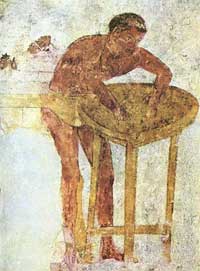 Preparation for the feast (detail), ca. 340—280 B.C. Orvieto, Golini tomb |
|
| Lake Corbara The road that runs around the lake from Orvieto to Todi is particularly spectacular as winds in and out of a number of wooded gorges around the course of the Tiber. The lake takes its name from the village of Corbara, in the Comune of Orvieto, which dates back to the 13th century when Andrea di Montemarte was imprisoned by the inhabitants of Todi and obliged to retire to the castle of Titignano and Corbara.
Other natural reserves in the vicinity are the protected areas of Sette Frati and Villalba. They offer picnicking facilities, shelter huts and marked footpaths for walkers. Sette Frati is close to the Tiber River Park (in the Comune of San Venanzo -Tr) and covers an area of roughly 25 hectares at 800 metres above sea level, commanding unique views over the Tiber Valley. |
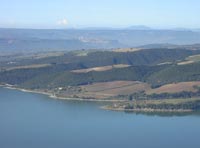 Lago Corbara and Orvieto |
|
| Abbazia dei SS. Severo e Martirio is an old Benedictine monastery about four kilometers away from Orvieto. In 1103 Countess Matilde di Canossa built the church's dodecagon crenelated tower. The Chiesa del Crocifisso belonged to the Compagnia del Crocifisso. The arms above the portal belonged to Cardinal Erminio Valenti, and the inscription (1608) records his patronage. |
|
|
| Castel Viscardo, which lies 13 km from Orvieto was developed around the ancient Castello dei Duchi di Montevecchio (the Castle of the Dukes of Montevecchio). Of note, the parish Church, within which one can admire an Annunciazione di Maria and a flag of a Turkish ship, which was a war prize of an expedition of a member of the Spada family. Under the family Monaldeschi's domination, Castel Viscardo with its small but strong army, took part on the Lepanto's battle and succeded in wrenching a flag from the pennon of a Turkish ship. This trophy, twenty metres long, was carrying a half moon of massive silver on the flag-staff, was brought to Castel Viscardo. At Castel Viscardo, during the 16th Century, the production of bricks was very important: the Fornaci are an evidence of this fact, which have produced raw materials for the restoration projects of important monuments such as the Colosseo, Piazza del Campo at Siena, and others. Of the four hamlets which belong to the comune of Castel Viscardo, Monterubiaglio and Viceno both grew up around medieval fortresses. The other hamlets are Le Prese and Pianolungo . |
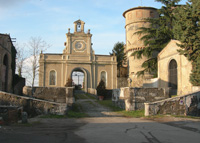 Castel Viscardo |
|
| Monterubiaglio is a small hilltop village, below Castel Viscardo. The name Monterubiaglio literally means red garlic mountain. Of particular interest are the old kilns right outside the inhabited center, one of the few places where hand-made bricks and tiles are still produced. Outside the walls is the church of the Madonna delle Grazie, erected in 1625 on a pre-existing chapel and, not far from the town, the ruins of the Abbey of Aqualta and the Franciscan convent of the Scarzuola together with the architectural fantasies of Tommaso Buzzi. The Franciscan Convent of the Scarzuola was founded by Saint Francis of Assisi who stayed here in a hut made of scarza or bark. Next to the convent is Tommaso Buzi’s Ideal City, an esoteric small-scale citadel, with a wealth of symbolic references, inspired by an allegorical text by Francesco Colonna. |
||
Monteleone d’Orvieto is an old medieval hamlet, located between Chiusi and Orvieto. Although Monteleone has two old churches — the 17c Madonna delle Grazie and the Franciscan convent of La Scansola — the town's primary importance was as a defensive bastion at the northern edge of Orvieto's territories. More medieval defensive works can be seen at the nearby hamlet of Poggio della Croce, where some Roman tombs have also been found. |
||
| Ficulle The medieval town of Ficulle is located on a ridge from which it overlooks a splendid valley with woods, badlands and flowering fields that reach up to the slopes of Mount Amiata. The town has eloquent traces of its ancient origins. The Romans had an observation post here on the Via “Traiana” (Cassia Nuova), one of the most important communication routes between Rome and the north of the peninsula. In the Middle Ages the “Castrum Ficullensis” was fortified and was frequently sacked and plundered during the long period of feudal struggles. It continued to be the most important castle of the city of Orvieto. In the twentieth century Ficulle was assigned a preeminent position in the territory of upper Orvieto and covered the role of district capital. Historical monuments The entire town is a monument, to which the two medieval fortresses, defenses for the town, and the medieval complex of Castel Maggiore bear witness. There are also fine monuments such as the old Rural Parish Church or Pieve of Santa Maria, built around 1200 with a fine Gothic portal and a few important frescoes dating to the second half of the fifteenth century. A few kilometers from the town, in the direction of Orvieto, is the Castello della Sala, once a Monaldeschi feud, a typical example of medieval architecture. The Abbey of San Nicolò al Monte Orvietano, built in 1007 by Saint Romuald, is surrounded by woods overlooking the Chiani valley. |
||
Allerona is a picturesque hill town in the mountains 19 km northwest of Orvieto. |
||
| Park “Selva di Meana” The Regional Park of “Selva di Meana” stretches out over an area of around 3000 hectares and includes the towns of Allerona and Castel Viscardo. The territory consists almost exclusively of woods and ranges from the Mediterranean maquis to deciduous woods, oaks and with a wealth of wild orchids. The area centers on the course of the River Paglia and its affluents, a vital artery in the system, where freshwater crayfish, the dipper and the European pond terrapin can still be found. The hidden jewel in the center of the Park is the splendid Villa Cahen, built in 1904 for the family of the Cahen bankers, in art nouveau style, surrounded by greenhouses and theme gardens. The villa is used as a study center by the Forestry Department as well as a center for university training in environmental subjects. It is to be noted that the area of Selva di Meana together with the adjacent Regional Park of Monte Rufeno (in Lazio) will soon form a single large inter-regional Park. |
||
| A walk in the Enviromental Archaeological Park of Orvieto (PAAO) |
||
| The entrance is situated in Palazzo Crispo in Piazza Marconi: with the necropolis of Cannicella and its walks among archaeology and nature, the PAAO represents a more naturalistic way of accessing the heart of the city. Another breathtaking walk is the walk that winds around the walls of the city through the medieval nucleus of the city and gives magnificent sights of the surrounding valleys. |
||
| Anello della Rupe |
||
| Anello della Rupe is a path that goes around the entire rock of Orvieto, in a succession of hills that define the perimeter of the massive tufa rock on which the city rests. There are several entrances to the path around town, the most popular is in Piazza Cahen, called "Le Piagge". Walk down the street near the fortezza dell’Albornoz and cross the beautiful porta Rocca. Along the path there are several maps indicating your spot and interesting facts about the scenery. Look for small wooden signs reading “percorso”, to follow the correct path around the entire rock. Walking in Tuscany | Anello della Rupe (Ring around the cliff) |
||
| Walking in Tuscany | Walking in the surroundings of Orvieto |
||
Just across the border in Lazio, in de comune Acquapendente, lies the nature reserve Monte Rufeno (2893 ha). Walking in Monte Rufeno
|
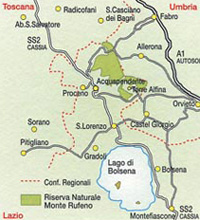 |
|
| The hills between Orvieto and Città della Pieve |
||
| This particular route is 103 kilometres long, and given also the various climbs involved, it is only really suited to fit cyclists. For those fit enough to be able to do the ride, however, it is well worth the effort, as the itinerary is a magnificent one that touches upon important artistic towns, such as Orvieto and Città della Pieve, as well as areas of outstanding natural beauty, like the Selva di Meana (between Fabro and Allerona) and Monte Nibbio. Città della Pieve, an Etruscan-Roman town that has preserved a large proportion of its old buildings, the most important of which being: the Cathedral, which houses paintings by the town’s two most famous painters, Perugino and Pomarancio, the Church of Santa Maria dei Bianchi, with the extraordinary Adorazioni dei Magi by Perugino. Other buildings of interest are the Rocca (a fortress built in 1326 compete with five towers), the sixteenth-century Palazzo della Corgna, Palazzo Bandini, the eighteenth-century Palazzo della Fargna and Palazzo Baglioni. Other places of interest in the local area include Allerona, situated in the middle of the woods near to the public nature reserve of Selva di Meana, a wonderful forest in the midst ofwhich there is even the only Liberty-style building in Umbria with an Italianate garden, Villa Cahen. Nearby there is another small nature reserve, Parco di Villalba, consisting of more than 20 hectares of public parkland. Then there are the ancient hilltop villages of Fabro and Ficulle, which offer visitors some wonderful views of the surrounding countryside. Sala Castle, situated not far from Ficulle, is a medieval construction that originally belonged to the Monaldeschi family, who made it an impenetrable fortress at that time. The Franciscan Monastery of La Scarzuola, founded by St. Francis in 1218, is situated near to Montegiove. The hills between between Orvieto and Città della Pieve | download pdf Password santapia
|
 Joseph Mallord William Turner, View of Orvieto, Painted in Rome 1828 |
|
| From Orvieto around Lake Corbara to Todi |
||
| This route across the hills around the reservoir know as Lake Corbara, touches on two world-famous towns of artistic importance, Todi and Orvieto, while also winding its way through some splendid, wild countryside. Just outside of the town walls of Orvieto, one can visit the Etruscan necropolis entitled the Tufo Crucifix, dating from the 4th/5th century BC, with chamber tombs built out of blocks of tufo rock. Other places of interesting along the route include the ancient villages of Prodo, Montecchio, Baschi and, above all, Civitella del Lago, famous for its delightfully panaoramic position overlooking Lake Corbara. Then there is the Forello Gorge Gole del Forello (Forello Gorge), and Scoppieto with a there a Roman ceramic factory dating from the 1st century AD. From Orvieto around Lake Corbara to Todi | download pdf Password santapia From Orvieto to Civita di Bagnoregio |
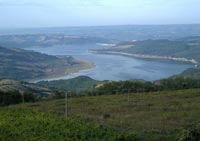 |
|
| From Piazza Cahen, looking at the funicular station, take the downhill road to your right, that borders the walls of the Albornoz Rock. Keep on walking downhill and turn right once you have walked past the city walls. Keep to the main path as you go downhill. You will notice the imposing tufa rock overlooking you. After approximately 900 metres, you will cross a tarmac road, the Strada Comunale Corta Stazione (the short municipality station road). Turn right and proceed keeping to the side of the road for approximately 200 metres. You will see the imposing monastic complex of the Abbey of Saints Severus and Martyrius in the background, which dates back to the early Middle Ages. Turn left at the crossroads and proceed uphill along provincial road SP 111 dell'Abbadia following signs to Porano.[...] There is public transport to go back to Orvieto, and you can take the COTRAL public bus from the terminus in Bagnoregio's Piazzale Battaglini. Transport | www.cotralspa.it Trekking in Tuscany and Lazio | From Orvieto to Civita di Bagnoregio
|
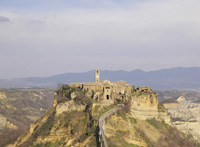 Civita di Bagnoregio |
|
Orvieto frazioni are Bagni di Orvieto, Bardano, Baschi Scalo, Benano, Biagio, Botto di Orvieto, Canale di Orvieto, Canonica, Capretta, Ciconia, Colonnetta di Prodo, Corbara, Fossatello, Morrano, Orvieto Scalo, Osteria Nuova, Padella, Prodo, Rocca Ripesena, San Faustino, Sferracavallo, Stazione di Castiglione, Sugano, Titignano, Tordimonte and Torre San Severo.
|
||
|
Enlarge map |
||
Comuni in the Province de Terni, in southern Umbria | Acquasparta · Allerona · Alviano · Amelia · Arrone · Attigliano · Avigliano Umbro · Baschi · Calvi dell'Umbria · Castel Giorgio · Castel Viscardo · Fabro · Ferentillo · Ficulle · Giove · Guardea · Lugnano in Teverina · Montecastrilli · Montecchio · Montefranco · Montegabbione · Monteleone d'Orvieto · Narni · Orvieto · Otricoli · Parrano · Penna in Teverina · Polino · Porano · San Gemini · San Venanzo · Stroncone · Terni |
||
San Brizio Chapel in Orvieto Cathedral |
||
|
San Brizio chapel was built at the beginning of the 15th century on the place of sacristy of the Orvieto Cathedral. The decoration of the chapel started in 1447 by Fra Angelico and Benozzo Gozzoli, who executed two compositions (Christ the Judge and Prophets) on the vaults. The commission was only revived at the end of the century. The painter Luca Signorelli was chosen thanks to his fame as a fast executor. Indeed, starting the work in April-May 1499 he finished it already in 1502.
His massive frescoes of the Last Judgment (1499–1503) in Orvieto Cathedral are considered his masterpiece. In the grand and dramatic scenes, inspired by the Divine Comedy of Dante Alighieri, Luca Signorelli displayed a mastery of the nude in a wide variety of poses surpassed at that time only by Michelangelo. [read more] Fifty-two years before, in 1447, Fra Angelico had spent three months and a half in this Cathedral of Orvieto, painting the spandrels in the roof of the Cappella Nuova, as it was then called. He had time to complete only two frescoes. In the principal space, that over the altar, he painted Christ in glory, surrounded by a mandorla, with angels on either side, and in the spandrel on the right, a group of sixteen prophets, seated pyramidally against a blaze of gold background. It is probable that he had thought out the general scheme of the frescoes, and that Signorelli only carried out his intention in working the paintings into one great whole — Christ in Heaven, surrounded by Angels, Apostles, Martyrs, Virgins, Patriarchs and Fathers of the Church, witnessing from on high the execution of divine justice below. However that may be, it is certain that Signorelli, in his painting of the roof, kept most scrupulously to the older master's arrangement, and in one of the spandrels actually seems to have worked over his design. [read more | Luca Signorelli by Maud Cruttwell]
|
||
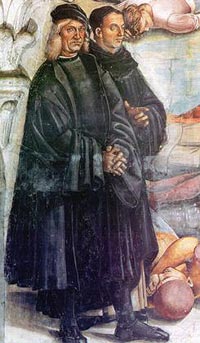 On the wall featuring stories of the Antichrist, Signorelli painted an exquisite portrait of himself (left) and his fellow artist Fra' Angelico. |
||
This page uses material from the Wikipedia articles Orvieto and Orvieto DOC published under the GNU Free Documentation License.
|
||
|
||||
Spoleto, duomo |
Castiglioncello Bandini |
San Qurico d'Orcia |
||
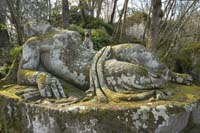 |
||||
Bomarzo |
Castell'Azarra |
Il parco dei Mostri in Bomarzo |
||
| Orvieto Restaurants |
D.O.C. Orvieto - Wine tasting | |||
|
Etrusca - Via Maitani 10, Orvieto - Truffles, mushrooms - Wine cellar 60 places 0763 - 344016 |
The production area of Orvieto D.O.C. includes the mostly hillside territories of Orvieto, Allerona, Alviano, Baschi, Castel Giorgio, Castel Viscardo, Fabro, Ficulle, Guardea, Montecchio, Montegabbione, Monteleone d’Orvieto, Porano and a part of Viterbo territory in Lazio. It is among the more representative Umbrian wines, known since ancient times, and covers about 70% of the D.O.C. production of the Province of Terni. Wine tasting Enoteca Regionale in Orvieto P.zza S.Giovanni, 1 Orvieto old town Placed in the old cellars of the ancient monastery. It hosts most important Wines of Umbria, DOC, DOCG, IGT, that have been given a prize. Visits, wine tasting from 11,00 am. to 5,00 p.m. - Close on Sunday Phone 0763 -793342 - Follow the signs for "Centro Storico", Parking area " Campo della Fiera", then take the elevator to Piazza San Giovanni. Enoteca Foresi (wine tasting and shop ) Piazza Duomo, 2 Orvieto - 0763 - 341611 Enoteca La Loggia (wine shop) Corso Cavour Orvieto 0763 - 344371 Orvieto terra d'Umbria (Wine shop) Via Duomo, 23 Orvieto 0763 - 343074 Ristorante Trattoria L'Angolo |
|||
 |
||||
Podere Santa Pia, situated in a particularly scenic valley, which overlooks on the hills around Cinigiano,
up to the Maremma seashore and Monte Christo |
||||


